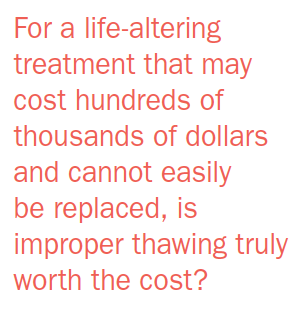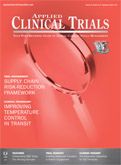The Success of Cell Therapies Will Depend on Automation
Applied Clinical Trials
Automation will be key to improving efficiency and mitigating risk during the complex process of cell therapy production and delivery.
Cell therapies are among the most promising new drug therapeutics since the rise of monoclonal antibodies. Globally, thousands of clinical trials based on live cell therapies are already taking place, with some analysts predicting a market value of $180 billion for this industry within the next 15 years. The pace of innovation and the opportunity to improve clinical outcomes for oncology, stroke, and heart attack patients, to name a few, are truly staggering.
To give cell therapies the best chance of success, now is the time to ensure that every protocol or technology involved in delivering a live therapeutic to a patient meets the highest standards of integrity, efficacy, and consistency. It is imperative to demonstrate that we, as a community, can standardize, document, and scale up best practices for optimal patient care. As part of this process, it behooves us to take a hard look at each step in the production and delivery of cell therapies, and find ways to reduce the potential for human error. Automation will be key to this effort, as it improves efficiency and mitigates risk.
As an example, let’s look at something that conceptually sounds rather simple: cell thawing. This is typically the last step before a cellular therapeutic is injected into a patient. Without automation, the thawing process is

unstandardized, undocumented, and prone to contamination. Technicians tend to improvise with cell thawing precisely because it appears at first glance to be basic; running vials or cryobags under warm water, floating them in a water bath, or even rolling vials between their hands. Even with the most scientifically validated methodology, using water baths is notoriously risky due to potential bacteria/fungi infection, and risk of contamination via microscopic tears in cryobags, or leaking cryovial caps.
The highest concern is that these unstandardized thawing methods can lead to decreased function of live cell therapy products by reducing viability and proliferative capacity or by shifting the ratio of cell types in a mixture. For a life-altering treatment that may cost hundreds of thousands of dollars and cannot easily be replaced, is improper thawing truly worth the cost? It’s all too easy to imagine these problems ruining a clinical trial that might otherwise be quite successful if the therapeutic were properly handled.
At MedCision, our scientists have a passion for eliminating human error. Based on demand from clinical trial companies and other organizations involved in the cell therapy field, we’ve developed an automated technology to ensure standardized, carefully controlled thawing of live cell therapies in a range of cryobags or vials. Compared to a water bath, this approach results in a highly reproducible thawing profile, along with higher viability and cell recovery for improved long-term function.
Making things as simple as possible is our mantra for any kind of clinical automation, and it’s a good guiding principle for anyone looking to innovate this industry. Our automated cell thawing technology is highly standardized, incorporating advanced sensors to detect phase change and complex algorithms that calculate a precise optimal thawing time for each unique drug. The end user, however, never sees any of this complexity. Instead, a simple design allows a one-step operation that can be accomplished with little to no training.
Cell thawing is just one step in the post-manufacturing chain of custody for live cell therapy products; there are many other areas where automation will be essential to improving reproducibility and robustness for delivering these high-value live treatments. I encourage the cell therapy community to question every protocol involved in shipping, storing, and administering these therapies, and to identify other components in the process that would benefit from more standardized methods. Optimal approaches typically include instruments or workflows in which parameters and processes can be fully locked down so they perform the same way every time, regardless of user or conditions.
Through automation we can incorporate software for recording and tracking data, which, in turn, helps ensure regulatory compliance, chain-of-custody reporting, and, ultimately, more predictable treatment outcomes. Greater consistency will also reduce the overall cost of therapy, resulting in a win-win situation for everyone.

Rolf Ehrhardt, MD, PhD, is CEO of MedCision
